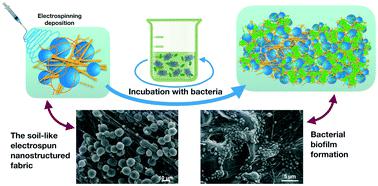当前位置:
X-MOL 学术
›
Environ. Sci.: Nano
›
论文详情
Our official English website, www.x-mol.net, welcomes your
feedback! (Note: you will need to create a separate account there.)
A 3D soil-like nanostructured fabric for the development of bacterial biofilms for agricultural and environmental uses
Environmental Science: Nano ( IF 5.8 ) Pub Date : 2020-06-30 , DOI: 10.1039/d0en00268b Fabrizio De Cesare 1, 2, 3, 4, 5 , Elena Di Mattia 2, 3, 4, 6 , Eyal Zussman 7, 8, 9, 10 , Antonella Macagnano 4, 5, 11, 12
Environmental Science: Nano ( IF 5.8 ) Pub Date : 2020-06-30 , DOI: 10.1039/d0en00268b Fabrizio De Cesare 1, 2, 3, 4, 5 , Elena Di Mattia 2, 3, 4, 6 , Eyal Zussman 7, 8, 9, 10 , Antonella Macagnano 4, 5, 11, 12
Affiliation

|
The present study aimed at creating a solid nanostructured scaffold suitable for the development of bacterial biofilms, and that enabled bacteria to successfully resist harsh nutritive and environmental conditions for potential applications. As a model system, we combined a self-standing electrospun nanostructured poly(ε-caprolactone)-based scaffold (EN-PCLS) with Burkholderia terricola cells. The scaffold structure was fabricated on purpose to include microbeads and nanofibres, and mimic the 3D morphological and spatial architecture of soil at the microscale and nanoscale, thus favouring the development of suitable biofilms. The resulting 3D framework displayed an extensive porosity and pore interconnectivity, and a honeycomb wax cell-like arrangement reproducing large cavities in soil. The bacteria first deposited a conditioning film onto the EN-PCLS to facilitate adhesion. The bacterial attachment was preferentially observed on the nanofibres with cells prevalently oriented along with them, and it persisted until late incubation under stirring. Notably, beads appeared bacteria-free if deprived of nanofibres on them. Over time, the interaction was improved in terms of stability upon the formation of appendages and release of extracellular polymeric substances (EPS). The more stable adhesion to the nanofibres enhanced the colonisation until the formation of flat bacterial aggregations in the nanofibrous areas inside the honeycomb wax cell-like frames of the EN-PCLS. Also, 3D micro- and macrocolonies were formed, and hung to nanofibres in between the microbeads of the honeycomb wax cell-like walls. Such microbial organisation evolved into a mature 3D biofilm within 7 d incubation, where bacteria formed densely packed layers of cells embedded into and coated with the EPS matrix that covered as a thick blanket the whole soil-like EN-PCLS. At the final stage of biofilm development (11 d), the biofilm and scaffold frameworks both appeared partially degraded, with the latter being probably utilised as a C-source. Hence, the observed soil-like 3D nanostructured architecture proposed here has successfully enabled soil bacteria to develop biofilms on more natural supports than in traditional studies. Thus, this strategy seems promising in creating scaffolds to be used as successful nanobiotechnological carriers for applications in both agriculture (nutrient supply and control of plant diseases) and environment (bioremediation of polluted soils and wastewater).
中文翻译:

一种用于农业和环境用途的细菌生物膜开发的类似3D土壤的纳米结构织物
本研究旨在创建一种固体纳米结构支架,适用于细菌生物膜的发展,并使细菌能够成功抵抗潜在的营养和环境条件。作为模型系统,我们将自立式电纺纳米结构聚(ε-己内酯)基支架(EN-PCLS)与土伯克霍尔德氏菌结合在一起细胞。脚手架结构的制造目的是包括微珠和纳米纤维,并在微观和纳米尺度上模拟土壤的3D形态和空间结构,从而有利于开发合适的生物膜。生成的3D框架显示出广泛的孔隙率和孔互连性,并且蜂窝状蜡状单元排列在土壤中复制出大的孔洞。细菌首先在EN-PCLS上沉积了一层调节膜促进粘附。优先在纳米纤维上观察到细菌附着,其中细胞通常与它们一起定向,并且这种细菌附着一直持续到搅拌下孵育结束。值得注意的是,如果珠子上缺少纳米纤维,则它们看起来是无细菌的。随着时间的流逝,相互作用在附属物的形成和细胞外聚合物(EPS)释放的稳定性方面得到改善。对纳米纤维的更稳定的附着力增强了定植,直到在EN-PCLS蜂窝状蜡细胞状框架内的纳米纤维区域内形成扁平细菌聚集为止。同样,形成了3D微殖民地和大殖民地,并悬挂在蜂窝状蜡状细胞壁的微珠之间的纳米纤维上。这种微生物的组织在孵化7天后演变成成熟的3D生物膜,细菌在其中形成紧密堆积的细胞层,这些细胞嵌入并被EPS基质覆盖,并被厚厚的毯子覆盖,整个土壤状EN-PCLS。在生物膜发展的最后阶段(11 d),生物膜和支架框架都出现了部分降解,后者可能被用作C源。因此,与传统研究相比,此处提出的观察到的类似土壤的3D纳米结构已成功地使土壤细菌能够在更多的自然支撑物上形成生物膜。因此,该策略在创建支架上似乎很有希望,该支架可以用作成功的纳米生物技术载体,用于农业(营养供应和植物病害的控制)和环境(污染土壤和废水的生物修复)中。
更新日期:2020-06-30
中文翻译:

一种用于农业和环境用途的细菌生物膜开发的类似3D土壤的纳米结构织物
本研究旨在创建一种固体纳米结构支架,适用于细菌生物膜的发展,并使细菌能够成功抵抗潜在的营养和环境条件。作为模型系统,我们将自立式电纺纳米结构聚(ε-己内酯)基支架(EN-PCLS)与土伯克霍尔德氏菌结合在一起细胞。脚手架结构的制造目的是包括微珠和纳米纤维,并在微观和纳米尺度上模拟土壤的3D形态和空间结构,从而有利于开发合适的生物膜。生成的3D框架显示出广泛的孔隙率和孔互连性,并且蜂窝状蜡状单元排列在土壤中复制出大的孔洞。细菌首先在EN-PCLS上沉积了一层调节膜促进粘附。优先在纳米纤维上观察到细菌附着,其中细胞通常与它们一起定向,并且这种细菌附着一直持续到搅拌下孵育结束。值得注意的是,如果珠子上缺少纳米纤维,则它们看起来是无细菌的。随着时间的流逝,相互作用在附属物的形成和细胞外聚合物(EPS)释放的稳定性方面得到改善。对纳米纤维的更稳定的附着力增强了定植,直到在EN-PCLS蜂窝状蜡细胞状框架内的纳米纤维区域内形成扁平细菌聚集为止。同样,形成了3D微殖民地和大殖民地,并悬挂在蜂窝状蜡状细胞壁的微珠之间的纳米纤维上。这种微生物的组织在孵化7天后演变成成熟的3D生物膜,细菌在其中形成紧密堆积的细胞层,这些细胞嵌入并被EPS基质覆盖,并被厚厚的毯子覆盖,整个土壤状EN-PCLS。在生物膜发展的最后阶段(11 d),生物膜和支架框架都出现了部分降解,后者可能被用作C源。因此,与传统研究相比,此处提出的观察到的类似土壤的3D纳米结构已成功地使土壤细菌能够在更多的自然支撑物上形成生物膜。因此,该策略在创建支架上似乎很有希望,该支架可以用作成功的纳米生物技术载体,用于农业(营养供应和植物病害的控制)和环境(污染土壤和废水的生物修复)中。











































 京公网安备 11010802027423号
京公网安备 11010802027423号